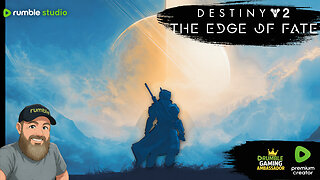Premium Only Content

New Research: Not ALL Senescent Cells are Bad!
As we age the number of senolytic cells or zombie cells we have in our body increases, this is a bad thing, although a new study seems to show that some zombie cells actually help in the healing process.
DoNotAge 10% Discount Code: MYNMN (https://bit.ly/2VBDgNt)
Renue by Science 10% Discount Code: MYNMN (https://renuebyscience.com/?rfsn=5692699.331801&coupon-code=MYNMN)
Renue by Science 15% Subscription Service Discount Code: MYNMNSUB
I hope you enjoy my content and find it interesting or informative, if so, please consider supporting the channel by using one of the links below:
* Buy me a Kofi: https://ko-fi.com/mynmnexperiment
* Patreon: https://bit.ly/3hhfjl5
* SubscribeStar: https://bit.ly/3psYo23
My Current Anti-Aging Protocol:
• 1.5 grams of NMN (https://bit.ly/3c2Fxt8)
• 1.5 grams of Trans-resveratrol (Tue, Thu & Sat) (https://bit.ly/3yxeqy2)
• 500mg Metformin
• 1.5 grams of TMG (https://bit.ly/3oe1Ted)
• 5,000 IU (International Units) of vitamin D3 (https://bit.ly/3P32hYH)
• 120 mcg (micrograms) of vitamin K2 (Mk 7) (https://bit.ly/3PhkBgn)
• 250mg Magnesium (L-Threonate) (https://bit.ly/3O4pZ5o)
• 200mg high molecular weight hyaluronic acid (https://bit.ly/3P0Z4c2)
• 2,400mg of Fisetin, on the 1st, 2nd & 3rd of each month (https://bit.ly/3P2rSB0)
• 2,400mg of Quercetin, on the 1st, 2nd & 3rd of each month (https://bit.ly/3IzulAy)
• 81mg of aspirin (https://bit.ly/3uFjtem)
• 800mg SIRT6 Activator
• 600mg DIM
Links:
https://www.nia.nih.gov/news/does-cellular-senescence-hold-secrets-healthier-aging
https://bit.ly/3jptlqu
https://www.science.org/doi/10.1126/science.abf3326
"Zombie cells" that contribute to age-related diseases also help heal damaged tissues, so wiping them out could come with major downsides. The zombie cells, scientifically known as "senescent" cells, are cells that stop multiplying due to damage or stress but don't die; this according to the National Institute on Aging. These zombie cells then release a slew of molecules that summon immune cells and this in turn spark inflammation.
The immune system regularly clears these zombies from the body, but with age, the system becomes less efficient; and as a result, the dysfunctional cells accumulate. This accumulation produces more inflammation, which in turn contributes to the development of age-related diseases such as cancer, Alzheimer's disease and osteoarthritis.
But zombie cells aren't entirely bad. This new study, conducted in lab mice and on human cells, suggested that senescent cells helped repair lung tissue after damage by encouraging stem cells to grow. Killing these zombie cells with Dasatinib, a cancer treatment, and Quercetin, a naturally occurring polyphenol – a drug duo that's been studied as a potential treatment to combat aging and age-related diseases - was found to somewhat disrupted this repair.
Tien Peng MD, an associate professor of pulmonary, critical care, allergy and sleep medicine at the University of California, San Francisco said
"We are not the first lab to implicate senescence as a wound-healing process. A 2014 study in the journal Developmental Cell found that zombie cells helped mend wounds in the skin and that their repair can also be disrupted by senolytics. This suggests that using senolytics could come at a cost, so the drugs will have to be designed to block zombie cells' bad effects without disrupting their good ones.”
To find senescent cells in the lung, researchers genetically modified mice to carry a glowing protein on the gene that codes for the protein "P16," which is overactive in many senescent cells. Whenever a cell switched on the gene, it would also churn out fluorescent proteins and start to glow. The researchers used this technique to "really amplify this signal," Professor Peng said, and thus revealed cells that carry low levels of p16; cells that may have otherwise escaped notice. Glowing cells appeared in mice's lungs shortly after birth, and their numbers increased over the rodents' life spans. The cells included fibro-blasts, which make connective tissue, as well as immune cells; they reside within a sheet-like tissue called the "basement membrane." The basement membrane is a sort of gatekeeper, it singles out and blocks harmful chemicals and pathogens from entering the lungs. But, at the same time it also allows oxygen to pass unhindered into the bloodstream.
DISCLAIMER: This video and description contain discount codes, which means that if you use the code, I will receive a small commission.
FAIR-USE COPYRIGHT DISCLAIMER
Copyright Disclaimer Under Section 107 of the Copyright Act 1976, allowance is made for "fair use" for purposes such as criticism, commenting, news reporting, teaching, scholarship, and research. Fair use is a use permitted by copyright statute that might otherwise be infringing. Non-profit, educational, or personal use tips the balance in favor of fair use. #Quercetin #Fisetin #Senolytics
-
 12:32
12:32
My Longevity Experiment
4 months ago $0.09 earnedI’m 60, Here’s Why I Now Avoid PEOPLE
1512 -
 23:58
23:58
Stephen Gardner
8 hours ago🔥Obama THROWS Adam Schiff under the bus to obstruct Trump!
27.6K111 -
 38:44
38:44
The Why Files
4 days agoProject Ancient Arrow | The NSA's Secret War Against Our Future
63K74 -
 2:36:06
2:36:06
Barry Cunningham
10 hours agoPRESIDENT TRUMP IS TRULY USHERING IN THE GOLDEN AGE OF AMERICA! CAN YOU FEEL IT?
114K44 -
 3:47:25
3:47:25
SynthTrax & DJ Cheezus Livestreams
3 days agoFriday Night Synthwave 80s 90s Electronica and more DJ MIX Livestream 2K Celebration SPECIAL EDITION 530pm PST / 830pm EST
55.7K5 -
 2:21:54
2:21:54
VapinGamers
7 hours ago $3.67 earnedDestiny 2 - Edge of Fate Legendary Run Part 3 - !rumbot !music
31K -
 2:04:25
2:04:25
TimcastIRL
9 hours agoTrump DOJ Gives Ghislaine Maxwell Limited IMMUNITY As She Rats On 100+ People | Timcast IRL
238K179 -
 1:09:09
1:09:09
Omar Elattar
11 hours agoThe Brain Experts: Your Brain Can Rewire Itself At Any Age & Here's How!
27.7K4 -
 4:30:37
4:30:37
IcyFPS
7 hours agoLIVE - Wuchang Fallen Feathers x Borderlands w/ pope!
35.9K2 -
 29:24
29:24
Afshin Rattansi's Going Underground
21 hours agoWas Epstein a Mossad Agent? Will Obama go to Prison? (Afshin Rattansi vs Alan Dershowitz)
34.9K28